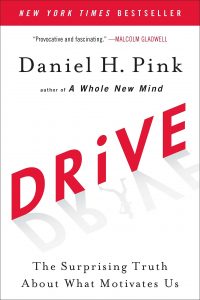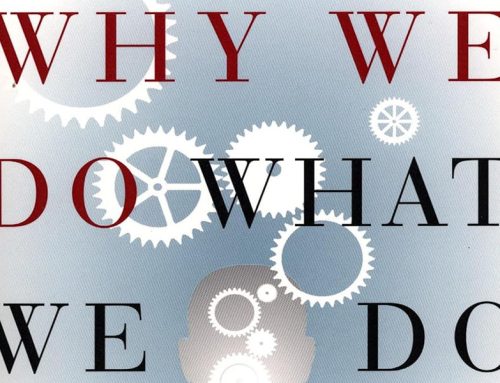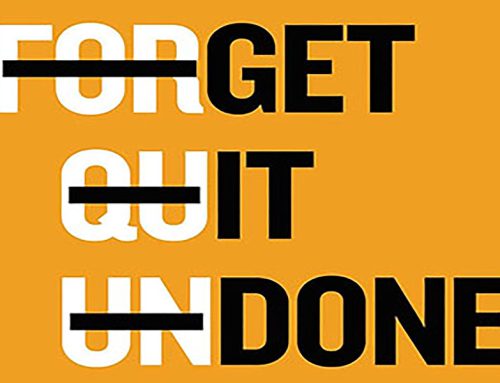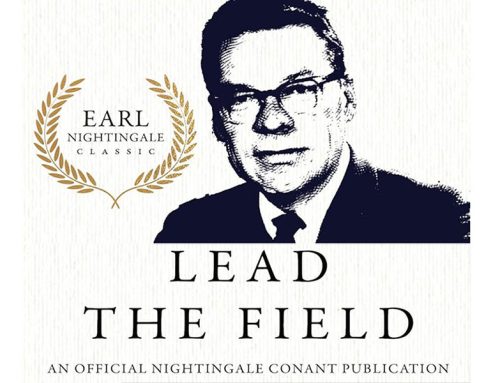As far back as the 1940s, psychologists knew humans had two types of drives. One is biological drive, which includes motivation to eat, drink, and reproduce. Another is external drive – the rewards and punishments delivered by the environment for acting certain ways. Based on early experiments that produced behaviors which couldn’t be explained by these two drives alone, a psychologist named Harry Harlow proposed that there was a third drive, understanding it is a key to motivation, and that much of what we think we know about motivation is wrong…
 Harlow called this third drive intrinsic motivation.
Harlow called this third drive intrinsic motivation.
When this third drive is invoked, the performance of a task itself is gratifying, enjoyable and becomes the reward itself.
Harlow went on to say that the old model of why we’re motivated to do what we do was incomplete. He believed that to really understand human behavior, we needed a new model that accounted for this third drive.
This theory was entertained for a while, but never took off again until another psychologist picked it back up in 1969. At that time, Edward Deci, a grad student at Carnegie Mellon, was also studying what motivates people, and he too suspected that most academics (and businesspeople) misunderstood it.
Deci had some ideas of his own, which he called self determination theory, and he started doing research to find out what was the effect of giving or not giving rewards on the way a task was worked on and completed. What he discovered was that when money was used as an external reward for some activities, the subjects lost intrinsic interest in the activity. He concluded that external rewards give a short term boost in motivation, but the effect wears off.
Deci’s theory was that humans have an inherent tendency to pursue novelty and challenges, but if we want to promote intrinsic motivation, we shouldn’t focus only on external control or reward systems.
After Harlow and Deci’s pioneering work, other psychologists took the ball and ran with it, and theories of intrinsic motivation were developed further and shared more widely.
This is what Daniel Pink’s book Drive is all about – the new, updated model of motivation, and how much of what most people believe about external rewards being our main driver is incomplete or wrong.
I read the book in 2010 and while I pulled out a handful of useful points, it didn’t fully resonate or click with me the first time through, maybe because it was mostly about business management. The book did however, put intrinsic motivation on my radar, and lead me to read the work of Deci and others who had been writing about self-determination theory.
Eventually I picked up the book again and this time, I read slowly, intently, and through the filter of, “How can we apply this to fitness and body weight management?” We could use a better model of motivation for fitness too, because for years I’ve been seeing people get motivated for a little while, lose weight, but then promptly gain it all back – and do this over and over again.
After re-reading it, and having been exposed to self determination theory as well, I got a lot more out of it. When I finished the book for the second time, I saw more clearly how many of these concepts are as applicable to getting leaner, healthier and fitter as they are to improving performance on the job or in creative work.
Although Drive definitely falls in the business category, I would still recommend that people interested only in health and fitness motivation read it. However, this review could save you that reading time as it gives a complete summary of all the key points, as well as a bonus section I’ve written at the end, which takes the principles of intrinsic motivation from the book which were mostly given in a business context, and shows you how almost all of them transfer directly to health and fitness motivation.
(If your interest is purely fitness motivation, feel free to jump ahead to the list of 9 ways to tap into intrinsic motivation for fitness at the bottom of the page)
Drive is split into three parts. Part one looks at the flaws in the reward and punishment system and proposes a new way to think about motivation. Part two looks at the three elements of intrinsic behavior – autonomy, mastery, and purpose – which Pink says are the genuine ingredients of motivation. Part three is a toolkit (appendix) of resources including exercises, question lists, resources, and summaries.
Why Carrots And Sticks Don’t Always Work
For years it had been assumed that the way to improve performance, increase productivity, and encourage excellence is to reward the good and punish the bad (using “carrots and sticks”). But a handful of psychologists noticed that numerous examples, including open-source projects, voluntary blood donation, non-commissioned artwork, non-profit corporations, and results-only workplaces suggested that this assumption was flawed.
These psychologists challenged the old assumption that rewards and punishments were necessary to motivate humans to achieve much. They suggested that people have higher drives, and if these drives were understood and respected, this could benefit individuals and organizations, including businesses.
The new idea was that the strongest and most persuasive driver is not external incentives alone, but having a challenging task, feeling creative working on a project with autonomy, while having fun and enjoying the work for its own sake.
External rewards do work, but they appear to work better for algorithmic tasks, which are the ones where you follow a set of established instructions down a specific pathway to one conclusion. These tasks tend to be routine, unchallenging, and directed by others.
External rewards don’t seem to work as well for heuristic tasks – the ones that involve problem-solving, inventiveness, and creativity. These tend to be less routine, more challenging, and more self-directed. They are also seen as more enjoyable.
In the workplace, a certain amount of reward in the form of compensation is necessary. If this level of baseline reward isn’t adequate, a person’s focus will be on the unfairness, it will lead to anxiety, and there’s very little motivation at all. But once we go past this threshold, rewards and punishments don’t always work like most people think.
Using the old carrot and stick model of motivation alone or in the wrong circumstances can even backfire in unexpected ways. It can extinguish intrinsic motivation, reduce performance, dampen creativity, become addictive, lead to short-term thinking, and even encourage cheating or unethical behavior.
A key motivational principle, inspired by Mark Twain’s Tom Sawyer fence painting story, says that “Work is whatever a person is obliged to do, while play is whatever a person is not obliged to do.” Rewards can turn interesting work into a drudge and diminish intrinsic motivation. Finding ways to turn work into play can increase motivation.
Rewards aren’t inherently motivation-sapping, but when rewards are contingent on doing something – as in, “If you do this, then you’ll get that” – there may be negative effects. The reason is because it’s forfeiting some of your autonomy. If people don’t feel like they’re fully controlling their lives, they enjoy the task less, and motivation drops.
If someone’s pay for creative work is contingent on a successful product or project completion, he will work like mad for a short while, but become less interested in the job in the long term. If a student is offered to be paid for each page of a workbook that is completed, she will study and work harder in the short term, but lose interest in math in the long term.
Organizations and businesses can’t assume that adding or raising incentives will always improve performance, especially long term. This hidden cost of contingent rewards is considered one of the strongest findings in social science and has started to change the way many businesses try to motivate employees.
When the focus is placed primarily on external rewards, creativity often drops off. It’s believed that this is because incentives can cloud creative thinking, cause self consciousness, and make a project to feel more like work and less like joy.
For people like artists, inventors, scientists, and students, intrinsic motivation – the drive to do something because it is interesting, challenging and absorbing – is essential for high levels of creativity.
For altruistic or noble tasks, such as giving blood, adding financial incentives can reduce the giving. The reward is thought to taint an altruistic act and push out the intrinsic desire to do something good (It’s supposed to be a feeling that money can’t buy).
It’s well-established that goal setting is important and it works. Having goals cuts out distractions, and keeps us focused. Goals keep us trying harder and working longer. Goals that people set for themselves are usually productive and healthy. But goals imposed by others (externally) may have negative effects, and focusing only on immediate rewards may hurt performance over time.
Contingent rewards may lead to narrower thinking. One can be so focused on the prize that creative solutions in the periphery can’t be seen.
If a goal or an external reward is the only destination, this can also produce shortcut-seeking and short-term thinking with no regard to long term consequences (including using quick fixes that are unsustainable, which undermines long term results). Focusing only on immediate rewards may hurt performance over time.
Studies have shown that if people are paid to exercise or stop smoking, it works well in the beginning, but the healthy behavior usually ends when the external incentives are removed. Cash, trophies and so on can provide motivation and satisfaction at first, but it may not last.
Rewards can become addictive too. Once a contingent reward is offered, it becomes expected whenever the same task is done in the future and the task may not ever be done again without that reward. The same size reward may not even motivate anymore.
Genuine motivation from within does not take a short term view – instead it focuses on mastery, which by definition is long-term.
Elite athletes and artists, for example, never feel like they have fully mastered their game or craft – they work on getting better and becoming more and more competent for life. As Daniel Pink wrote, “Greatness and near-sightedness are incompatible. Meaningful achievement depends on lifting one’s sights and pushing toward the horizon.”
Improving The Old Model Of Motivation
The old model of motivation appears incomplete and in need of an upgrade, but this doesn’t mean rewards are always bad. For routine tasks that aren’t very interesting and don’t require a lot of creative thinking, incentives seem to give a motivational boost without any harmful side effects.
Rewards don’t undermine intrinsic motivation for routine tasks because routine tasks don’t have any underlying intrinsic motivation to undermine – they’re mechanical, repetitive skills. In this case, in the workplace, the higher the pay, usually the higher the performance. It would be ideal to try to make these boring tasks fun, but if that’s not possible, rewards should help.
To help motivate others to complete routine tasks, the following suggestions are offered:
1. Offer a rationale for why the task is necessary.
2. Acknowledge that the task is boring (and see if there are ways to make the task less boring, more varied, or more challenging).
3. Allow people to control the task their own way (give them autonomy / freedom over how they do their job).
Another way external rewards may be beneficial, not harmful, is after ensuring baseline compensation is fair, and the three elements of motivation are in place, give a reward that is unexpected, and only after the task is complete (instead of an “if-then” reward, it becomes a “now that” reward).
In addition, consider offering non-tangible rewards like praise and positive feedback. This can increase intrinsic motivation. For the most beneficial effect, praise specifically (give useful information), praise the effort and praise the strategy.
To help motivate others to complete creative, deep thinking types of work, Pink says the most important thing in the new model of motivation is to downplay external rewards and find ways to emphasize the three deeper elements of motivation:
1. Autonomy
2. Mastery
3. Purpose
Pink’s formula for the new, more effective type of motivation closely parallels what psychologists Edward Deci and Richard Ryan discovered in their work on self determination theory.
Self determination theory starts with the premise that we have three innate psychological needs – autonomy, competence, and relatedness. The theory states that when these needs are met, we are motivated, productive, and happy. When they are thwarted, our motivation, productivity and happiness plummet.
Self determination theory also says that using rewards specifically to motivate can have the opposite effect. So instead, we are instructed to focus our efforts on creating an environment where our three innate psychological needs can flourish.
Hundreds of studies on self determination theory in multiple areas of endeavor in life have come to the same conclusion: Humans have an innate drive to be autonomous, feel more and more competent and to feel connected to other people. Understanding and applying this is one of the major keys to lasting motivation that comes from within.
Autonomy
Having a sense of autonomy, where you feel you have control over your work and your choices, has a powerful effect on individual performance and attitude. According to the research, autonomous motivation promotes higher grades, more persistence at school, work and in sports, higher productivity, less burnout and improved psychological well-being.
Psychology also says that feeling as if you are in control is also a major component to happiness. It’s innate to humans to move in the direction of greater freedom.
In business, organizations that are practicing the new model of motivation are offering autonomy in four areas of work: what people do, when people do it, how they do it, and whom they do it with (also known as the four T’s: task, time, technique, and team. Companies including Google, 3M, Zappos and many others have improved performance and achieved some of their biggest breakthroughs or inventions by building these types of autonomy into their company cultures.
One more tactic that successful companies are using is to create an environment and culture that turns work into play. Some tasks may be repetitive and mundane, but since they must get done, employees can at least be given some freedom to do these jobs in a way that is more challenging and engaging.
Encouraging autonomy doesn’t mean discouraging accountability. It’s also important that people are accountable for their work. The old motivation model assumed that without rewards and punishments, if people were given too much freedom, they would shirk their work because there wasn’t accountability. The new model of motivation assumes that people want to be accountable, and having control over their task, time, technique and team is a different pathway to being accountable.
The opposite of autonomy is control. Control leads to compliance while autonomy leads to engagement. The old model of motivation was to get people to comply (to do things in a certain way) using rewards and punishments. The new model of motivation says that we should pursue engagement because engagement leads to mastery. Pursuing mastery produces superior and longer lasting performance because it meets our innate human need to feel competent and feel as if we are getting better at our craft.
Mastery: Feeling Competent, Getting Better And Experiencing “Flow”
Forcing compliance with rewards and punishment is not a good strategy for personal happiness and fulfillment. The better approach is to create an environment where you have the opportunity in your work to engage in peak experiences, also known as being in the state of “flow,” where time seems to pass quickly, self-consciousness disappears, and you almost feel as if you’re in a trance. In this state, the experience feels fulfilling for its own sake. The activity feels so good, it becomes it’s own reward.
These peak states of flow are best achieved when there are clear goals, and you get immediate feedback on how you’re doing in relation to your goal. It’s also most easily achieved when the task is a challenge but not too difficult nor too easy (it’s in the “Goldilocks zone”). You’re working on something just a notch above your current abilities so it makes you stretch your body and mind in a way that makes the effort feel like the most rewarding experience.
A major frustration for many in the workplace is the frequent mismatch between what people are required to do and what they can do. If what they are required to do exceeds their capabilities, the result is anxiety. If what they are required to do falls far short of their capabilities, they don’t feel challenged, and the result is boredom (lack of motivation).
When the match is just right, the results can be spectacular. People want to be challenged – at just the right level. One study of 11,000 scientists and engineers working at companies in the United States found that the desire for intellectual challenge – specifically, the urge to master something new and engaging – was the best predictor of productivity.
There are three laws of mastery.
First, mastery is a mindset. People can hold two different views in mind about their abilities and intelligence. One is that the intelligence or ability in us has a finite supply that we can’t increase (entity theory aka fixed mindset). The other is that our intelligence or ability is something that with effort, we can increase (incremental theory aka growth mindset). If you choose the growth path, it takes you down the road of mastery. With the growth mindset, it’s easier to keep working in spite of difficulty, and find more creative strategies to find solutions.
The second law is that mastery is a “pain.” Research shows that one of the best predictors of success is a trait known as grit, which is defined as perseverance and passion for long-term goals. Even though the path of mastery may have many exquisite moments of flow, it is not all unicorns and rainbows. If it were, more people would be successful. The truth is, mastery is not always fun – it can be painful. Mastery may not require as much innate talent as most people believe, but it does require a lot of focused practice and time-consuming effort. If grit is a key to success, it means not just working harder, but working longer without changing targets.
Mastery involves dedication to continuous effort and perseverance over time even when you’re seeing very little improvement. But the reward is great. The effort itself is one of the things that gives life meaning. Putting in the effort means you care about something, it’s important to you and you’re willing to work for it. Life would not be as fulfilling if you were not willing to value things and commit yourself to working toward them.
The third law of mastery is that mastery is an asymptote – a straight line that a progress curve approaches and gets closer and closer to but never quite reaches. Whether we are talking about art, science, sports, fitness, writing, academics, or any other ability or area of endeavor, we work on mastery our entire lives, and with grit, we can approach it, hone it, and get very close to it, but we can never actually touch it. Even athletes like Tiger Woods flatly state that they must get better. They say it when they are amateurs and they still say it at what appears the height of their professional carers. You can’t fully realize mastery, but you can pursue it, and that keeps you engaged and motivated from within.
Purpose
People who are autonomous and working toward mastery perform at very high levels. But when these people also are working toward some higher purpose, greater than themselves, they achieve even more.
The importance of purpose has moved to the forefront of our consciousness in recent years, not only in many businesses, but also on a personal level, as a huge swath of the population reached their sixties and started to question whether they had achieved all they wanted to in life. The realization that there were many unfulfilled dreams made purpose a new focal point for a large number of individuals.
Purpose provides the energy for action. Psychology research suggests that achieving wealth alone is not a strong enough motivational catalyst to fully mobilize human energy. The profit motive is not enough. More attention needs to be placed on the purpose motive. More and more people of all ages are saying that money is not their most important form of compensation. More important are things like giving back, volunteering, making the world a better place, and working with a great team (a sense of connectedness).
In addition to higher levels of performance, people who have purpose goals (as opposed only to profit goals), report higher levels of satisfaction and subjective well-being, in addition to low levels of anxiety and depression. Interestingly, even when people reached their extrinsic (profit) goals, they did not report satisfaction and self-esteem as any higher than before. Getting what we want does not always mean it was what we need. The profit motive is important in many ways, but it’s in human nature to seek purpose.
Intrinsic Motivation For Fitness: 9 Ways To Tap Into It
Because this concept of intrinsic motivation is so relevant and critical in business, the majority of examples in Daniel Pink’s Drive are put into business and economic contexts. That made this book a popular read for managers and entrepreneurs. There is also some discussion about intrinsic motivation in the educational system, so there’s much to be gained by teachers, coaches, and students understanding these concepts as well.
These principles also have implications for people working in creative fields – from inventors to writers to artists. However, most of these ideas can be applied to increasing motivation in all kinds of endeavors – including fitness.
The author obviously agrees, as he gives a very brief two-page section about fitness in the back. There are indeed some important and powerful ways you can use these ideas about lasting motivation for health and fitness. Here is a list that includes a few of Pink’s recommendations, combined with additional ideas of my own based on self-determination and intrinsic motivation theories:
1. Choose your own nutrition plan.
Do not follow cookie cutter diet plans. Keeping in mind the importance of autonomy, always customize your nutrition to your own goals, lifestyle, schedule, and personal preferences. Never let any coach, expert or guru shoehorn you into their one eating philosophy – it may not be the right one for you. Do not feel pressured to follow any diet brand or philosophy 100% by the book – take parts that fit you and discard the rest.
If you like eating carbs, do not follow a low carb diet – you won’t sustain it. If you need the help, hire a coach to guide you and give you important targets like calories, macros, and food selections, but make sure you have the freedom to decide how you will hit those targets. For example, a calorie deficit is non-negotiable for fat loss, but you have many options for how you do it. You should pick the diet that gets you in the calorie deficit in the most painless way possible. Above all else, make sure the plan you choose is sustainable.
2. Choose your own training plan.
Choose the training plan that suits your goals, lifestyle, schedule, and personal preferences the best. Never let any coach, expert or guru force you into their one training philosophy – it may not be right for you. Do not feel pressured to strictly follow any workout plan or exercise philosophy 100% by the book.
Hire a coach to guide you, give you advice and help you set important targets like sets, reps, frequency, intensity, volume and so on, but make sure you have the final say in everything, and make sure you feel as if you have control over most of the program design. In addition, make sure the training plan you choose is sustainable, both in terms of how much work your body can handle, and what you can realistically fit into a busy schedule.
3. Set your own goals.
A great thing about fitness that’s different from business is that you can always choose your own fitness goals. Goals that are self-chosen usually produce sustainable motivation.
Getting healthy and fit so you can be there for your family or set an example for others is a good use of tapping into the power of purpose as long as the goal is your own choice. But starting a diet or training program because someone else is pressuring you to do it is not. Starting a specific type of trendy diet or training program because someone else thinks you should is also the wrong reason.
4. Set the right kind of goals for the right reasons.
People who pursue goals for extrinsic reasons, such as slimming down for a wedding, class reunion, or vacation very often reach those goals. Goal setting and external motivation does work and there’s nothing wrong with using something like the reward of a vacation as a short-term motivator. The problem is, people who depend only on external motivators usually gain the weight back or get out of shape again as soon as the target event ends.
People who pursue goals such as getting fit to feel good, to stay healthy for their family, to be a role model for others, to honor their creator, to master a training discipline, or any other intrinsic reason might see slower progress at first, but are much more likely to maintain their results in the long run.
5. Find a form of exercise you enjoy and do anything you can to make it more fun and engaging.
If you hate treadmills, then ditch the treadmill. If you dislike gyms, train at home. If you don’t like barbells, do resistance training with body weight, bands, or suspension straps. Whatever your preferences, it’s absolutely possible to find a form of exercise that’s not only enjoyable, but intoxicating – that gives you those feelings of having a peak experience (putting you in a state of flow).
It can go beyond resistance training and cardio training. It can include sports, martial arts, or even dancing. It could be group training or doing it solo. It could be recreation, or walking on the beach or in the park or woods. Using a progress journal and forever aiming to reach little daily workout goals and set new personal records can turn workouts that were a drudge into feeling like a game. Just as work can be turned into play, exercise can be turned into play as well.
6. Pursue mastery.
When you strive to get better at something, it gives you a great source of renewable energy. The martial arts are a prime example of a sport and discipline that people start and strive to master for life, and the concept of mastery is easy to understand in that context. But general fitness pursuits – resistance and cardio training – can also be approached as a craft that you work on mastering.
So pick some kind to training that you can get better at over time – not just increasing strength, endurance or other measures of fitness, but actually mastering the prescription and execution of training as if it were an art form. For some people, the type of training is crossfit, powerlifting, calisthenics, or Spartan races.
For me it’s bodybuilding, and I look at bodybuilding not only as a science but also as an art or craft. You could do it for a lifetime and never master it, but by seeking mastery, I never need outside motivation, the pursuit of mastering the craft is the reward. If there is outside motivation like a competition with a trophy, title, or award, it’s simply an extra boost and bonus.
7. Set goals of the right difficulty level.
Make your goals just a notch above your current ability. They should be challenging enough to make you stretch, but not so difficult or far away that they demotivate you. This is the “goldilocks zone” for goals – not too hard, not too easy. As you reach each higher level, continue to increase the difficulty level, always set new goals, and you will stay motivated.
8. Generally, don’t use if-then (contingent) rewards.
You may have heard before that when you reach a goal, you should celebrate it and appreciate it. But this doesn’t necessarily mean you should bribe yourself from the start with if-then rewards like, “If I do all 4 of my workouts this week, then I’ll buy myself new clothes. These types of rewards might help some people with short-term motivation, but a problem is that if you take them away, the motivation goes away as well.
In addition, a greater danger is that there’s a possibility contingent rewards could backfire by decreasing your intrinsic motivation over the long term. You can however, give yourself an occasional “now that” reward after you’ve achieved a goal (do something special for yourself) to acknowledge the achievement.
9. Get connected to other people and stay connected.
According to self-determination theory, one of our innate human needs is relatedness or connection to others. Recall that this theory says when our innate needs are met, we are not only more motivated but also happier. When these needs are thwarted, our motivation and happiness plummet. We are social creatures. Goals that have you interacting with others, giving and receiving help from others and nurturing relationships are going to fill your innate need for connection and improve your success rate.
Always have a social support system to plug into, whether online or in real life and ideally, both. Also consider whether you are the type of person who enjoys participating in exercise with a group. Not everyone does, but for some people, the community aspect of group fitness can be a game changer. (To learn more about our online fitness social community, visit: www.BurnTheFatInnerCircle.com).
A Short Summary
The closing paragraphs of the final chapter of Drive provide an excellent summary of the entire book in a few sentences:
“The science shows that the secret to high performance isn’t our biological drive or our reward and punishment drive, but our third drive – our deep-seated desire to direct our own lives, to extend and expand our abilities, and to live a life of purpose.”
“We’re not destined to be passive and compliant. We’re designed to be active and engaged. And we know that the richest experience in our lives aren’t when we’re clamoring for validation from others, but when we’re listening to our own voice – doing something that matters, doing it well, and doing it in the service of a cause larger than ourselves.”
Drive is available in all formats on Amazon: https://amzn.to/2RM19MA
-Tom Venuto






Leave A Comment